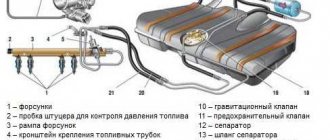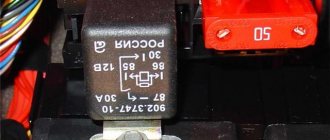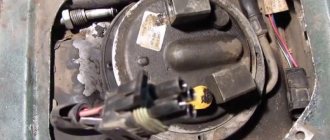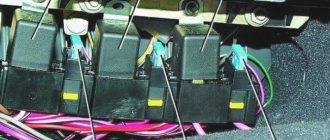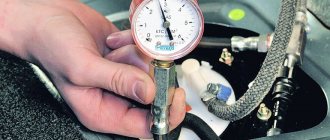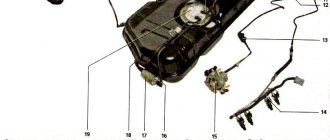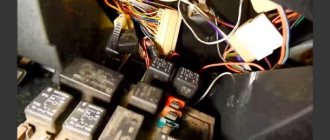Pressure can be checked in several ways. In this article we will describe the most commonly used ones.
To do this, you need to purchase a special kit, which includes:
- Special adapter for connection;
- Pressure gauge;
- Outflow.
All this will cost you about 1,500 rubles. You can also turn to specialists (service stations) for help, who will perform the test for 300-500 rubles.
However, there is a more interesting method that will allow you to do without additional costs. Fuel pressure can be measured using a pressure gauge to check tire pressure. To do this, it is better to use pressure gauges with a minimum limit (6-7 atmospheres). This will minimize the error as much as possible.
Now let's take a closer look at how to do this:
- First, prepare the pressure gauge and wrap it with fum tape directly under the manifold.
- Secondly, you will need a 9mm oxygen tube, place it on top.
Then secure the fasteners on both sides with clamps. To prevent fire, the generator should be covered.
Now reduce the pressure to minimum. It is not so difficult. To do this, remove the fuse that powers the fuel pump (on the VAZ 2110 it is located near the control unit, on the left under the trim).
The next step is to start the engine and wait for it to go out.
Unscrew the plug installed on the fuel rail.
Inside the cap there is a nipple and a standard hole. Then remove the wheel cap and unscrew it. Due to the presence of residual pressure, be prepared for a small fuel leak.
Now place the other end of the hose over the exit of the ramp and secure it with a clamp.
And the last step. Remove the “protection” from the generator and start the engine. But before that, do not forget to put the fuse in place.
This method of measuring fuel pressure is one of the simplest and most effective.
Normal pressure is between 2.8 and 3.2 bar (atm).
What pressure should be in the VAZ 2110 fuel system?
On a VAZ 2110 with 1.6 liter engines, the pressure in the ramp is constant and amounts to 3.6-4.0 atm. Otherwise, the measurement technique is similar. Alternative ways:
- It is measured at the outlet fitting of the fuel pump module - this is the one with one tube. You will need a flexible gas-resistant hose with an internal diameter of about 8 mm and a pressure gauge (you need to remove the tube and put on a hose with a pressure gauge instead). The pressure should be 5-7 atm.
- Close the return line, as is done on an internal combustion engine with a drain ramp, but you must turn it off again at the fuel pump itself. We pull off the second hose (double) and insert a plug into the removed hose, made, for example, from an old fuel filter (saw off the nipple from it and plug it). A single hose must be put on the pump fitting, and now the measurement must be made at the fuel rail. According to the power system diagram, everything will be clear.
1 – fitting for checking the pressure in the power system; 2 – fuel rail; 3 – nozzles; 4 – fuel line; 5 – fuel tank; 6 – fuel pump module (in the fuel tank); 7 – fuel filter; 8 – tee.
What devices are used
ATTENTION! A completely simple way to reduce fuel consumption has been found! Don't believe me? An auto mechanic with 15 years of experience also didn’t believe it until he tried it. And now he saves 35,000 rubles a year on gasoline! Read more"
Several instruments can serve as devices for taking pressure readings.
- A special device purchased from an auto parts store. It comes complete with an adapter, drain hose and pressure gauge. Costs about 1.5 thousand rubles.
- Converted tire pressure gauge. The instrument scale and tube are subject to modification. As you know, the air pressure gauge shows a value of up to 20 atm, and the fuel measurement limit is around 5-7 atm. For this reason, reading errors may occur, and the device is modified to take this into account. Regarding the tube: you need to change it to a gas-resistant version.
Problems with the car's fuel system
are expressed by failures at high speeds, jerking of the car, or the car does not move when you need to accelerate sharply, and sometimes it simply stalls. Now knowing how to check the pressure in the fuel system of a car, we can diagnose the car ourselves. We can determine which component of the fuel system has failed (gasoline pump, fuel pressure regulator (FPR), injectors, filters, etc.), but first we need to understand how the fuel system works: The gas pump continuously pumps fuel while the engine is running. Excess gasoline is stupidly dumped through the RTD into the return line.
The pressure in the ramp changes (increases) not so much with the speed, but at the moment of accelerating (this is clearly visible in the video), because at this moment the vacuum (vacuum) in the receiver drops and the RTD adds pressure in the ramp.
If you turn off the engine, the pressure in the ramp will slowly begin to decrease exponentially. The rate of decline (from several minutes to several hours) depends on the quality of the check valve, which is located on the back of the fuel pump motor. When diagnosing, pressure measurements in the system are made in different ways:
- Measuring how much the needle jumps when the ignition is on
- Measured at XX
- Measurement with the tube dropped from the RTD
- Metering with pinched return
Rail pressure indicator
It is extremely important to check the indicator in the fuel rail at the same time.
- For a 1.5-liter engine - 280-320 kPa.
- For a 1.6-liter power plant - 370-380 kPa.
On the other hand, there is no specific value for the pressure in the ramp. The norm for the performance of all elements of the fuel system is considered to be higher than 2.8 bar. As for the top point, there are no restrictions.
Here, for example, is what data should be there if there are no difficulties in the functioning of the vehicle and its elements.
- In XX mode the indicator should be 2.5 atm or higher.
- With the sensor tube removed – 3.3 atm and higher.
- When the return channel is clamped - 7 atm.
- When over-gasping – jumping up to three atm and gradual recovery by 2.5 atm.
If the indicator does not correspond to the factory values, we can conclude that the filters, pump or RTD (sensor) are faulty.
The pressure indicator on systems without return is slightly different. Here it can vary between 3.6 - 4 atm.
How to determine the status of the fuel pressure regulator (FPR)?
There are two ways to determine if an RTD is faulty:
- If the pressure with the engine not running with the fuel pump turned on is below 2.8 atm. To turn on the fuel pump directly without starting the engine, then on the diagnostic block we close the closest contacts to the gear shift lever.
- Turn off the fuel pump. The pressure in the ramp should drop by about 0.7 atm and remain at this level. If the pressure in the fuel system does not hold and immediately drops to zero, then the RTD or the pump check valve is faulty (located on the back side of the fuel pump motor; it is not advisable to change the pump because of it). Do not rule out cracks in the fuel line or poor condition of the injectors (gasoline flows in)
Determination of RTD performance
An RTD is a sensor that, if faulty, affects pressure readings in the entire system. To determine the performance of an RTD, 2 main methods are used.
- Close the nearby contacts on the diagnostic block near the gearshift lever if the pressure with the engine stopped is below 2.8 atm. A short circuit will allow the fuel pump to bypass the engine.
- Stop the fuel pump. Measure the pressure, which under normal conditions should drop to 0.7 atm and remain at this level, without varying. On the contrary, if the indicator instantly drops to 0, either the sensor is faulty or there is a problem in the pump return system. Fuel leaks, poor condition of injection elements, etc. are also possible.
How to determine the condition of the fuel pump?
In order to determine a fuel pump malfunction, you need to check the fuel pump “at the wall” (zero supply pressure or “at the plug”). In simple terms, this is the pressure that the fuel pump develops.
It is by this parameter that the service life of the fuel pump can be determined. As the pump wears out, this parameter gradually decreases. When the pressure is “into the wall”:
- about 3 atm - the car stalls
- 4 atm - the pump will still serve
- 5-7 atm – the state of the new pump (the Czech gas pump produces 7 atm)
Checking the fuel pump “for a plug” is quite simple; you need to pinch the return line with pliers (for 2-3 seconds) with the car running and watch the pressure gauge readings. Another way to check the fuel pump: smoothly raise the engine speed to 3000 rpm. If the pressure gradually drops, then this is a sign of a “dead” pump.
How to check the condition of the fuel system without a pressure gauge?
Unscrew the fuel supply line and apply power to the fuel pump. If everything is in order, then about 1.5 liters should flow in a minute. By the way, if the pressure in the fuel rail is only 1 atm and the sound of the pump is uneven. The reason is there is no gasoline in the tank! Now, if you stalled far from the city, then diagnosing the car yourself in the field is not a problem for you! Intense acceleration of the car without dips and jerks is the first sign of a serviceable fuel system of the car! If after such a diagnosis the problems remain, then pay attention to other points (compression in the cylinders, ignition module, etc.).
Different measuring methods
In addition to measuring against the wall, there are many other ways to measure yourself. One of the options for checking the fuel supercharger is the “plug” diagnosis. In this case, the return line is clamped for two seconds, the engine starts, and the pressure reading is taken.
Another testing option. The speed of the power plant increases to three thousand revolutions per minute. At the same time, you need to monitor the instrument readings. If the pressure drops to 0, this is a sign of a “dead” pump.
The pressure on the ramp is measured as follows:
- fum tape is wound around the pipe;
- the device hose is reinforced with a clamp (if homemade);
- a rag is placed on nearby parts to prevent fuel from spilling (especially carefully you need to close the generating device in order to avoid a fire hazard in the engine space);
- there is a cap on the fuel rail that needs to be unscrewed;
- access to the hole with the nipple is opened - the latter is unscrewed with a cap from the car wheel;
- To prevent gasoline from splashing too much, it is necessary to release the pressure in the vehicle in advance;
- the end of the meter hose is threaded into the ramp hole and is also secured with a clamp;
- The rag is removed, the engine starts, and readings are taken.
On a vehicle without return.
- It is necessary to measure the pressure at the outlet of the fuel pump module (located on the fuel tank). For measurements, a hose with a diameter of eight millimeters is suitable, which must be resistant to gasoline. An ordinary pressure gauge is suitable as a meter.
- The original hose is removed from the pressure gauge and an 8 mm one is inserted. Pressure readings are taken, which should be within 5-7 atm.
Measurements are made in different ways:
- with the ignition on, watch how much the scale needle jumps;
- measurements are carried out with the RTD (fuel sensor) hose removed;
- separate idle pressure test;
- check with a pinched return hose.
Causes of malfunction
The main causes of malfunctions of the VAZ 2110 fuel pump are the low quality of the fuel being filled, low fuel supply pressure, the regular presence of a small amount of gasoline (less than 5 liters) in the fuel tank and improper operation when starting the engine - before starting the engine, you must wait after turning on the ignition 2-4 seconds to pump fuel into the engine power system.
It is also possible that the fuel pump as a part will naturally fail, depending on the mileage of 150 - 200 thousand km. or for a period of 4-5 years, but again this malfunction depends on the operating conditions of the car itself. Usually the factory fuel pump is replaced with a BOSCH one.
There are secondary malfunctions of the VAZ 2110 fuel pump failure - failure of the relay, blown power fuse, they are located in the fuse mounting block either under the hood or in the lower left part of the dashboard, front console, depending on the engine modification, and contamination of the fine filter mesh fuel cleaning (located directly on the fuel pump).
These faults can be fixed relatively quickly and without large financial investments. Fuel pump repairs are performed quite rarely, and the cost of repairs relative to the cost of the pump is insignificant.
Injection pump pressure on a Mercedes
This is a high pressure pump installed on diesel cars and some gasoline cars.
This is how pressure is measured.
- Motor 4g93 starts.
- Take a multimeter, which is connected with one probe to the middle connector of the RTD chip. The second probe must be connected to the negative terminal of the battery.
- Indicators are taken.
The normal value should vary within 3 volts. If it is less, you need to raise the speed of the power plant and keep it within 2000 rpm. Adjust the pressure bolt in this mode by rotating clockwise. At the same time, you need to look at the device to stop rotation as soon as the pressure reaches the standard value of 3 volts.
If the pressure does not want to return to place, you can draw conclusions about a fuel leak or a malfunction of the fuel system elements, including the pump.
Video: how to measure the pressure of injection pump 4g94
Forget about fines from cameras! An absolutely legal new product - Traffic Police Camera Jammer, hides your license plates from the cameras that are installed in all cities. More details at the link.
- Absolutely legal (Article 12.2);
- Hides from photo and video recording;
- Suitable for all cars;
- Works through the cigarette lighter connector;
- Does not cause interference to radios and cell phones.
A fuel pump is essentially an electric motor that sits in a vehicle's fuel tank and pumps and delivers fuel to the injectors for injection into the combustion chamber at high pressure.
As a component and part of a car, the fuel pump is one of the important and finicky components of the car. With its help, fuel is supplied to the injector.
If used incorrectly, failure of this part can lead to consequences ranging from inoperability of the fuel system (especially during a long trip) to costly repairs of the entire engine power system.
Fuel pump VAZ 2110
Troubleshooting
The main symptoms of a malfunction of the VAZ 2110 fuel pump are engine interruptions in various operating modes, lack of pressure in the fuel system, loss of acceleration dynamics, increased fuel consumption, or complete failure when trying to start the engine.
The first step is to check the functionality of the pump. When you turn on the ignition, you should hear a slight whirring sound from the pump under the rear seat for a few seconds.
If the engine is running, it is necessary to check the fuel supply pressure using a pressure gauge; the fuel supply pressure to the injector should be 3.5 - 4 atmospheres. If the sound of the fuel pump is not heard, if you have an electrical tester, you can check whether power is being supplied to the pump.
To do this, you need to remove the back seat of the VAZ 2110, the decorative cover, and the terminal from the fuel pump housing, turn on the key to crank the starter, if the tester does not receive power, you need to check the relay, fuse or wiring trace for a break! If there is power, the fuel pump needs to be replaced.
The serviceability of the relay can be checked by replacing it with a working one from the fuse box, for example the high beam headlight relay. When replacing a new relay, you need to pay attention to the manufacturer and the recommendations of a spare parts specialist in the store; it is better not to save on the cost of the relay.
How to buy a quality device?
The price for a VAZ 2110 fuel pump in market conditions will be 2 times lower than in a specialized store. The equipment is in durable and sealed packaging. Inside the package is purified gasoline. If you smell gasoline, then the seal of the packaging is broken and there is a possibility of corrosion forming inside the gasoline pump. Submerged equipment is lubricated and cooled by fuel. When using low-quality additives and gasoline, internal electrical mechanisms are corroded. If additional substances are not used in the operation of the device (dry), then the brushes wear off and it overheats. The service life of the equipment is longer. Some car owners are planning to replace the VAZ 2110 Bosch fuel pump, the characteristics and pressure of which are not normal only due to long-term use. Its pressure can be 6-7 atmospheres. It was amazing to hear from an experienced driver his method for testing the fuel pump. To do this, he took a jar of water, turned it on on the battery, and by the flow of liquid he realized that the power of the gas pump had decreased.
Replacement
Replacing a fuel pump with a new one requires careful selection of the manufacturer; each pump has its own performance. The absolute leader in this area is BOSCH.
To replace or remove for repair the VAZ 2110 fuel pump we will need: a 17mm wrench, depending on the modification, a 10mm socket, pliers, a flat screwdriver. We remove the rear seat, it is advisable to unscrew the gas tank cap to relieve excess pressure in the system. Disconnect the plastic pump power terminal.
Depending on the modification, we remove the fuel supply and return hoses, or, by pressing the spring clip and pulling the hose, disconnect it from the fuel pump housing. In the second option, use a 17mm wrench to unscrew both fittings and disconnect the tubes.
In both cases, it is necessary to disconnect carefully, since the system is under pressure and when disconnected, the pressure will be released from the injector and a small amount of fuel will leak. If the performance of the old fuel pump is small, there will be no pressure in the system.
Unscrew the 8 nuts from the studs using a 10mm socket and remove the retaining ring with the seal. Carefully pull out the VAZ 2110 fuel pump housing at a slight angle so as not to damage the fuel level sensor; repairing it is unlikely. Using a screwdriver and pliers, remove the lower part of the fuel pump housing and remove the connectors and hoses from the pump. We dismantle the pump.
Assembly is carried out in reverse order. By the way, the original BOSCH fuel pump comes with a mesh. The new fuel pump has high performance, so after replacing it, when you turn on the ignition several times, there will be extraneous sounds when the system is pumped.
Bosch fuel pump performance - from 3 to 3.8 bar
The manufacturer Bosch produces its own fuel pump for each type of fuel system. Why, after the original fuel pump fails, do people install a Bosch fuel pump from a VAZ 2110? How does the pressure and performance of the fuel pump compare with the original one? If you put it with high pressure, will the flow rate increase?
Consumption does not increase due to the performance of the fuel pump, since on cars the return line is activated and excess fuel is returned to the tank, there is also a fuel pressure regulator, from the name it is clear, I think what function it performs.
Consequently, there was a 2.8 bar pump, they installed a Bosch VAZ 2110 fuel pump with 3.8 bar and it will only get better. Fuel consumption may increase if the fuel pump does not create sufficient pressure in the rail and the injectors begin to pour gasoline, which does not burn, rather than spray.
FLS
It is quite clear that we first learn about excessive consumption of gasoline by readings from the level sensor. However, sometimes the FLS also starts to lie, and then the true consumption cannot be known.
There may be a situation when you still have half a tank of gasoline, but the FLS says that the fuel is almost empty. That is, the flow sensor itself may confuse you, and before rushing to replace the regulator, make sure that the FLS is working properly, remember that the VAZ 2110 has problems with it very often.
If you notice that it is lying, the fuel sensor may need adjustment or even replacement.
Characteristics of the Bosch fuel pump 0580453453
Especially for my readers, I got confused and measured the fuel pump that is on my display case. In fact, the characteristics of Bosch gasoline pumps differ in the length and very rarely in the diameter of the body. Why? The diameter of the body can be adjusted using a gasket made of petrol-resistant rubber.
Most often, the characteristics of fuel pumps (not only Bosch, but also from other manufacturers) may differ in length, pressure, location of terminal chips and that’s it :). The fuel pump mesh does not differ in seating, but it may differ in shape. The chip for the terminal can be remade or supplied from the same VAZ. The length of the fuel pump is important, since its operation depends on this when the fuel level in the tank is low, and if it is in the module, then you need a match to install it.
Fuel pump length:
- Bosch fuel pump 0580453453 - 105 mm
- Bosch fuel pump 0580453449 - 65 mm
- Bosch fuel pump 0580453465 - 90 mm
